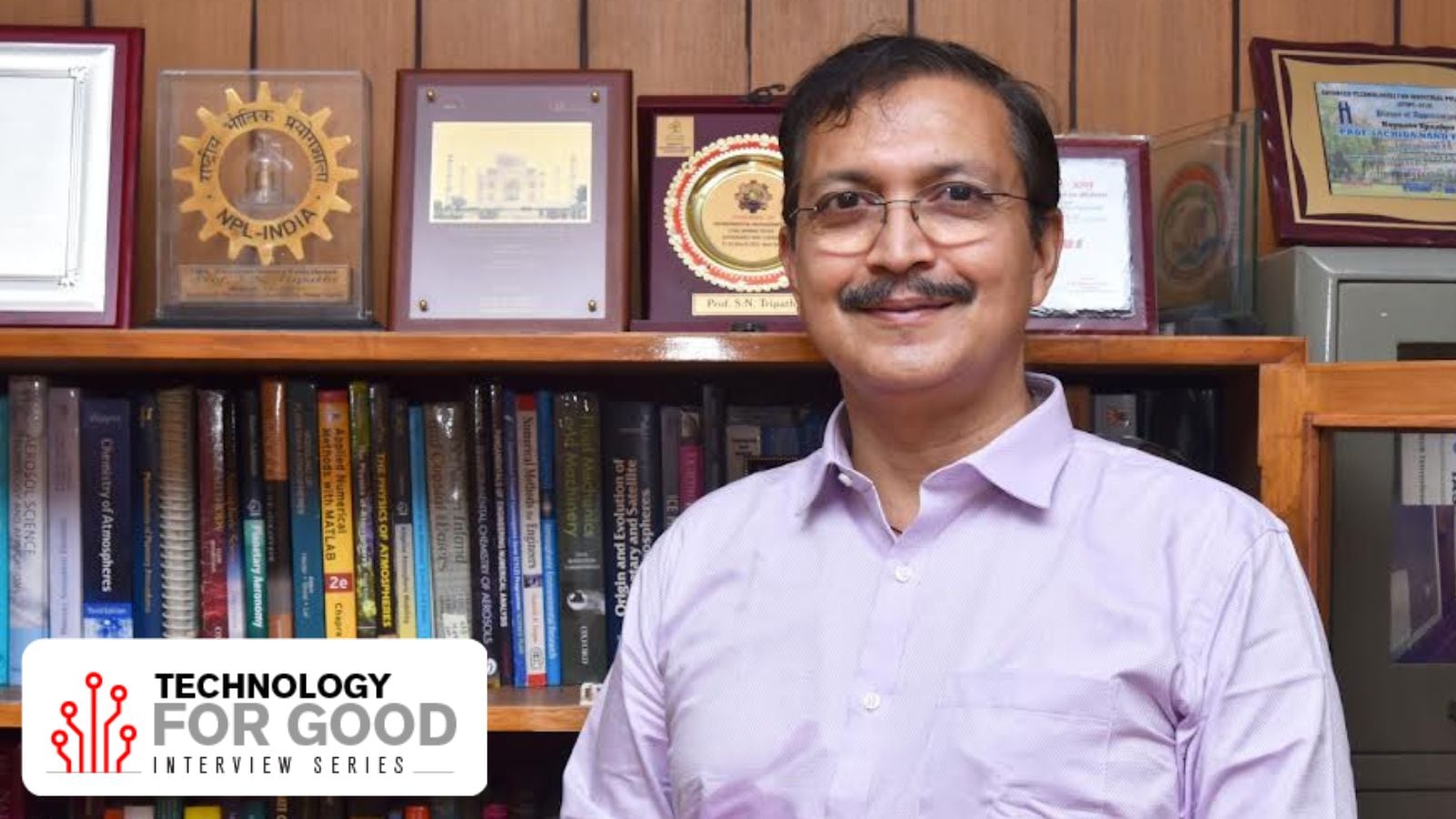Sachchida Nand Tripathi is the Dean, Kotak School of Sustainability, and Project Director, AI Centre of Excellence for Sustainable Cities at IIT Kanpur.
He also leads the Centre of Excellence for Air Quality Monitoring Technologies (ATMAN), which has developed new hardware and AI/ML-based analytical techniques that are being used by several states and cities in India. He has developed advanced air quality monitoring tech and has implemented the largest sensor-based air quality network in India.
Tripathi’s area of research includes aerosol-cloud interaction, regional climate changes, AI/ML-enabled dynamic hyper-local source apportionment, and sensor-based air quality monitoring.
An engineering graduate from IIT Banaras Hindu University, Varanasi, Tripathi has a PhD in Atmospheric Physics from the University of Reading and a postdoc in climate research from the University of Oxford.
Tripathi spoke to indianexpress.com on his journey in the sustainability space, the opportunities for the use of AI in monitoring environmental parameters and energy forecasting in Indian cities, and the sustainability startups that impressed him. Edited excerpts:
Venkatesh Kannaiah: Tell us about your research interests and your journey in the sustainability space.
Sachchida Nand Tripathi: I am a civil and environmental engineer by training. My doctoral work was in the area of aerosols — tiny particles suspended in the air — and I studied their impact on the climate system. Gradually, I started seeing a worsening trend in air quality, especially in North India. Particulate matter became a serious public health concern, accounting for roughly 85-90 per cent of the health impacts from air pollution. This issue became so severe that, around 2016, I shifted the focus of my work from climate impacts of aerosols to air quality.
We conducted several large-scale studies, including field experiments in Delhi-NCR, to identify the sources of pollution and understand the mechanisms by which haze forms and persists. One of the challenges was the lack of good air quality monitoring data. Outside of a few major cities, India had very few monitoring stations. Without accurate, granular data, it is very hard to understand the problem and design interventions.
Story continues below this ad
This is when I began working closely with startups to develop low-cost sensors for air quality monitoring, preferably made in India. In the early stages, these sensors were not accurate enough for large-scale deployment. Over time, by mentoring these companies and working with them on calibration, reliability, and deployment strategies, we were able to bring their performance much closer to reference-grade monitors.
To give you a scale of the gap: in states like Uttar Pradesh and Bihar, there were only around 100 continuous ambient air quality monitoring stations. That’s quite low for such a huge area. With support from these sensor startups and state agencies, we were able to add 1,380 more sensors, placing one in each administrative block. This dramatically improved the coverage.
We have done similar work in other cities — Delhi, Mumbai, Jaipur, Guwahati, Chennai, and even in Kanyakumari. Everywhere, the challenge has been the same: how to provide accurate, dense monitoring at a cost cities can afford.
Now, with low-cost sensors, accuracy is the central issue. Before deployment, each sensor is co-located with a reference-grade monitor to calibrate it. But once you place these sensors hundreds of kilometres away from any reference station, conditions change — temperature, humidity, particle composition — and the original calibration may no longer be valid. To address this, we use advanced statistical methods and machine learning to continuously adjust the calibration in the field. We have been working on this calibration challenge for five to six years, involving teams of data scientists, machine learning experts, and AI specialists.
Story continues below this ad
Through these projects, my work expanded beyond just air quality. It became clear that sustainability issues are interconnected. Sustainability is not a foreign concept; it has deep roots in Indian traditions and thinking. We just have to make it part of our growth model.
Venkatesh Kannaiah: How does the AI Centre of Excellence for Sustainable Cities connect with the Kotak School of Sustainability?
Sachchida Nand Tripathi: They are separate institutions but connected in vision and approach. I am the Dean of the Kotak School of Sustainability, which is funded through Kotak’s CSR initiatives. The Kotak School has a broad mandate — education, research, and outreach on all aspects of sustainability.
In parallel, I head the AI Centre of Excellence for Sustainable Cities. This is part of a national programme funded by the Government of India and involves participation from several IITs, the Indian Institute of Science, and multiple industry partners. The AI Centre has a sharper focus: using AI to make Indian cities more sustainable.
Venkatesh Kannaiah: Tell us about your work at the AI Centre.
Sachchida Nand Tripathi: The AI Centre’s work is organised into four main domains: first is monitoring, where we do both environmental and critical infrastructure monitoring. On the environmental side, we focus on air quality, using dense sensor networks, satellite data, and AI models to create actionable intelligence. On the infrastructure side, we monitor critical assets — bridges, dams, public buildings — using a mix of fixed sensors, drones, and other data collection tools. The data from these sources feeds into digital twins, which are regularly updated so that any potential problem can be detected early. Predictive maintenance becomes possible when you have continuous, reliable data.
Story continues below this ad
Secondly, we work on urban mobility to improve transportation efficiency using AI. We work with Chartr, a commuting app now serving commuters in Delhi. The app integrates GPS data from buses, metros, and even some auto-rickshaws to suggest optimal multi-modal routes in real time. The plan is to expand this model to at least 30 cities. We are also building digital twins of transport networks. These virtual models allow us to simulate interventions, like adding a feeder bus service or changing signal timings, before implementing them in the real world.
Thirdly, we work on energy forecasting, where we predict electricity and piped gas consumption accurately so utilities can optimise their supply. For example, for Adani Electricity in Mumbai, which serves three million households, our AI models have reduced forecasting errors. This might sound trivial, but in utility operations, it translates into significant cost savings. Similarly, for Adani Total Gas, we forecast PNG and CNG demand at the station level. This helps optimise distribution and reduce waste.
We also work on the urban governance front, where we build digital platforms to make interactions between citizens and officials efficient and transparent. Citizens should be able to report an issue, track its progress, and receive updates. Officials should be able to view all incoming issues, prioritise them, assign them to the right department, and monitor progress.
Ultimately, the goal is for these four domains to be part of an integrated urban digital ecosystem.
Story continues below this ad
Venkatesh Kannaiah: How independent is the AI Centre of Excellence in its operations?
Sachchida Nand Tripathi: The AI Centre of Excellence is set up as a Section 8 not-for-profit company. It is named as Airawat Research Foundation. We have a board of directors that includes senior representatives from our industry partners and directors of the participating IITs. I am the project director and also serve on the board.
Our CEO is a former IAS officer with a strong background in sustainability. We also have a CFO, a CTO, and dedicated teams for engineering, AI development, and project management.
The Government of India has provided a grant of Rs 310 crore for the first four years. After that, the Centre has to be financially self-sustaining. We aim to do that through a mix of technology licensing, providing services to cities, and possibly taking equity stakes in startups that we incubate or support.
Venkatesh Kannaiah: How do you balance research with real-world deployment?
Sachchida Nand Tripathi: That balance is built into our mandate. We are not here to produce research papers alone. We have to create products and services that are deployed in cities and actively used. Our success will be measured by whether, four years from now, our tools are running in multiple cities, solving real problems, and generating enough revenue to keep the centre operational without government grants.
Story continues below this ad
Venkatesh Kannaiah: How ready are Indian cities for AI?
Sachchida Nand Tripathi: Many cities, especially larger ones, have begun to engage seriously with the idea of using AI for urban management. This has been gathering momentum over the last seven to eight years due to the Smart Cities Mission.
Most of the Smart Cities had established integrated command centres, which brought together video feeds from CCTV cameras, data from environmental sensors, information from GPS-enabled public transport vehicles, and other operational dashboards. They have created a basic data infrastructure that can be built upon for AI applications.
The physical assets created under the programme are still there, and they can be repurposed for new applications. For example, the traffic camera feeds that were initially used mainly for law enforcement can also be used to build live congestion maps, which in turn can be fed into a digital twin of the city’s transport system for testing changes before they are implemented.
Another untapped resource is anonymised mobile phone data. Telecom operators already have data that shows population movement patterns at a large scale, but in India, we have not adopted data-sharing protocols that would allow such information to be used for purposes like mobility planning.
Story continues below this ad
Awareness is growing, and some infrastructure is in place. The next step is to deploy proven, problem-focused technologies that can integrate with existing systems without causing a major disruption.
Venkatesh Kannaiah: Could you name some startups in the sustainability space that are doing interesting work?
Sachchida Nand Tripathi: One that stands out is BioConcrete from the Netherlands. It’s an example of how biology can be integrated into traditional engineering materials. Their approach is to embed dormant but harmless bacteria, along with a nutrient source, into concrete. The bacteria remain inactive as long as the concrete is intact. But if a crack forms and water enters, the bacteria become active, consume the nutrient, and produce limestone as a metabolic byproduct. This limestone fills the crack from within, sealing it off before the damage can spread.
This is significant because in reinforced concrete, the steel bars inside can corrode rapidly once moisture gets in through cracks. Corrosion expands the steel, widens the cracks, and can lead to structural failure. By sealing cracks early and automatically, BioConcrete prevents moisture from reaching the steel, extending the structure’s life.
The process is completely autonomous — no human intervention is required once the bacteria are embedded. Repairs occur at the micro-crack stage, long before they are visible to the naked eye. The technology blends microbiology with civil engineering, creating a bio-hybrid material. It can be applied to structures that are hard to access for maintenance, like highway bridges, sea walls, and certain public buildings.
Story continues below this ad
Venkatesh Kannaiah: Tell us about Indian sustainability startups you are excited about?
Sachchida Nand Tripathi: There is Phool, based in Kanpur. They collect floral waste from temples, which would otherwise end up in rivers, and turn it into products like incense and “Fleather,” a sustainable alternative to leather. It’s a circular economy model that addresses both waste management and sustainable manufacturing.
Chakr Innovation, from IIT Delhi, has developed technology to capture soot particles from diesel generators, vehicles, and industrial chimneys. These soot particles are harmful black carbon, a potent climate warmer. Chakr’s system captures them before they are released into the air, and then processes them into usable products like ink. This transforms a harmful waste product into something with market value.
Venkatesh Kannaiah: What is your ask from the government?
Sachchida Nand Tripathi: It would be to make more data available for public-good applications. India’s diversity is unmatched, and training AI models on comprehensive Indian datasets would make them robust not only for India but for global use.
Right now, critical datasets are fragmented or inaccessible. For instance, the India Meteorological Department has decades of weather and climate data, but much of it is not freely available. Telecom companies have data on how people move around cities, but there is no standard, secure framework for sharing it.
If we do not create and use our own data-driven models, other countries or companies will, and we will end up paying to use systems that are built on our data but optimised for someone else’s context.




Average Rating